Music Commissions Home | Music Commissions Brief History | Music Commissions Articles List | Composer's Guide to the Piano Accordion
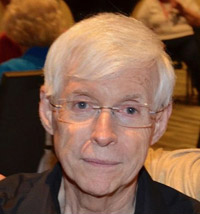
Following the first commission of the American Accordionists' Association Composers' Commissioning Committee in 1957, Paul Creston's landmark Prelude and Dance, the Committee Chairperson, Elsie Bennett, was soon able to obtain three more in close succession within a twelve-month span: Wallingford Riegger's Cooper Square, Paul Creston's Concerto for Accordion and Orchestra, and Virgil Thomson's Lamentations, contracted respectively in April 1958, July 1958, and April 1959.
All three composers were greatly respected figures in America's formative period in modern music. Creston and Thomson were generally regarded as the more conservative of the three while Riegger had a somewhat more radical reputation, both musically and politically.
Georgia-born Wallingford Riegger was one of America's earliest composers to utilize the more dissonant twelve-tone, atonal technique in his music and is consequently deemed by musicologists as one of the so-called "American Five" of adventurous, risk-taking composers stemming from the post-World War I era (the other four being Charles Ives, Carl Ruggles, Henry Cowell, who was eventually to accept two AAA commissions, and John Becker).
Although born in Georgia, Riegger grew up in Indianapolis and New York. As a member of the first graduating class (1907) of the Institute of Musical Art (re-named Juilliard School of Music after its principal benefactor nineteen years later), Riegger studied the cello with Alvin Schroeder and composition with Percy Goetschius. Then came three years of advanced work at the Berlin Hochschule für Musik with cellists Robert Haussman and Anton Hekking, and composition with Edgar Stillman-Kelley, culminating in his conducting début with the Blüthner Orchestra in 1910.
After his marriage to Rose Schramm (1911), Riegger spent three years as principal cellist with the St Paul Symphony Orchestra before returning to Germany in 1914 to become assistant conductor and voice coach at the Stadttheater of Würzburg. He took a similar post at Königsberg the following year and conducted the Blüthner Orchestra during its 1916–17 season before American entry into World War I forced him to return to the United States.
Politically, Riegger was an outspoken leftist who eventually found himself standing as a "witness" in front of the infamous House Committee on Un-American Activities (as did two other famous AAA commissionees, David Diamond, a close and admiring friend of Riegger and Elie Siegmeister) around the time he wrote Cooper Square.
Of the three pieces discussed in this installment, that of Thomson is the most radical and dissonant while both the Creston and Riegger offerings are quite consonant and almost "popular" in style. Though often working with atonal serial technique, Riegger took liberties with the rules while creating works that were in a freer atonal style, or in some pieces, applying other less dissonant twentieth century styles, including outright tonality, as will be seen in his accordion offering.
Elsie Bennett offered a contract to Riegger dated April 9, 1958 to write an accordion solo for $250 which he accepted. The resulting piece, titled Cooper Square, was first announced thirteen months later in an article by Elsie Bennett in the May 1959 issue of Accordion and Guitar World. It included the following brief description of the piece by the composer through Bennett:
| Cooper Square is a three-part song form ("A-B-A form") in 2/4 time, written in the key of E-minor. Its first part features a tango-like rhythm utilizing conventional harmonic structure. Its second part, somewhat speeded up in tempo, is more dissonant without being duodecuple [twelve-tone]. The third part is a return to the beginning followed by a coda. |
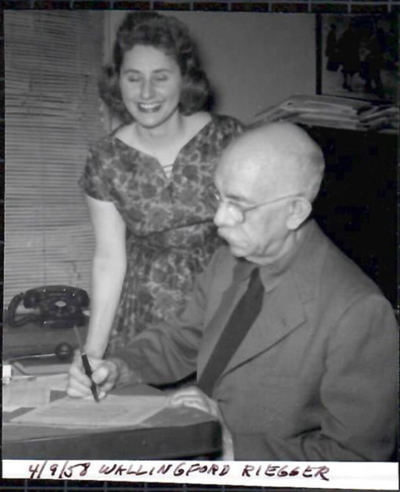
Elsie Bennett and Wallingford Riegger, April 9, 1958. Elsie Bennett photo album |
Riegger's title was undoubtedly inspired by and likely a tribute to a favorite hangout of contemporary composers and a number of future jazz greats in New York's Bowery of the late 1950s at 5 Cooper Square, located between 4th and 5th Streets two blocks south of Cooper Triangle park and the historic Cooper Union for the Advancement of Science and Art where in 1860 Lincoln gave his first speech declaring his candidacy for President of the United States. Appropriately named the "Five Spot Café," it was demolished seven years after Riegger's accordion piece was composed and re-established on nearby St. Mark's Place to make room for the present-day high-rise Evelyn and Louis A. Green Senior Residence.
It is likely that Riegger, like many other cutting edge New York composers of the day, was a frequent customer and exhibitor of his music and may have played or had played some of his works for anyone who would like to listen. If true, it is unfortunate that he did not say so in his very scant description above of his accordion solo or in his correspondence with Elsie Bennett in her vast preserved CCC correspondence files.

Left: Cooper Square in 1957. Right: the relocated 5 Spot at nearby 2 St. Mark's Place |
Expanding on Riegger's brief overview of the piece reveals a considerable amount of complexity and advanced development of ideas throughout.
Preceding the main body of the A section is a three-bar, rambunctious introduction mostly in rhythmic triplets, setting the mood of the "piu mosso" tango to follow. It employs a traditional tonic E-minor triad, followed by the supertonic F-sharp half-diminished 7th chord, that commonly leads to the B major-minor 7th dominant function, resulting in a common half cadence, pointing to the downbeat of the main theme tango.
For dramatic effect, however, the dominant 7th chord, sounding in the bass, is dissonated somewhat comically by an F-major-minor 7th chord in the right-hand manual, resulting in a jolting polychord music theorists refer to as a French augmented 6th spelling of the dominant 7th (except for a "wild card," the C, which adds a strong dissonance with the root, B, of the chord), not all that uncommon in highly dramatic moments in tangos. See Example 1.

Example 1. Introduction to the A section of Cooper Square, measures 1-3, with harmonic analysis in red. |
The A section theme proper (Piú mosso) follows for 22 measures in the treble, rhythmically and harmonically supported by a typical tango accompanimental figure haltingly sounding in two-measure spurts throughout. Melodic phrasing, harmony, and style are all in conventional tango style and tonality. See Example 2.

Example 2. Principle tango theme of A section, measures 4-19 |
The B section, also Piú mosso, but at a faster metronome marking, is more "modern" than its predecessor, as the composer indicated, and much longer (measures 23-87, 64 measures) and variable. There are many instances of parallel chord planing, and thus avoidance of traditional harmonic progressions, and much more chromaticism. However, all vertical structures maintain traditional tertian harmony, without any hints of dissonance or bitonal structure.
Also, this section represents a complete departure from the tango rhythms of the outer A sections. Frequent occurrences of bellows shake also add to the freneticism of the B section, not to mention an ascending glissando in parallel perfect 5ths on the white keys in one place. See Examples 3 and 4.
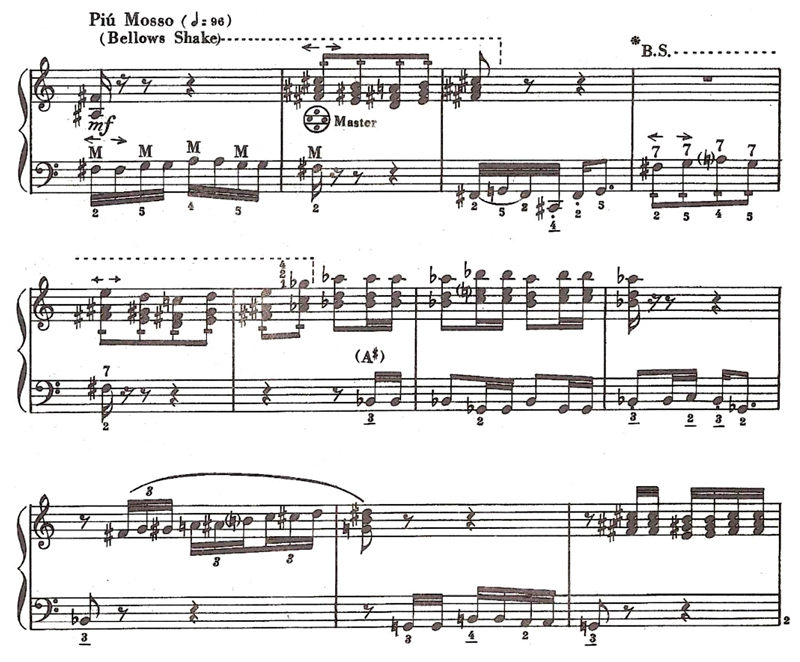
Example 3. Beginning of B section, measures 23-33. Bellows shake in first six measures. Parallel planing of root position triads in left- or right-hand parts, measures 23-25, 33 and incomplete major-minor 7th chords in either hand, measures 26-30. Both the triad and 7th chord planings also form non-tonal whole tone scale passages instead of traditional major or minor scales. Highly chromatic texture throughout as compared to the diatonic tonal structure of the A tango sections. |

Example 4. Dramatic upsweeping of right-hand glissandi in parallel 5ths on the white keys, measures 76-77 |
Amidst all this clamor, one rather playful, "skippy" melodic or rhythmic element occurs a few times in altered forms to give some stability, though not much, to this motion forward. See Example 5.
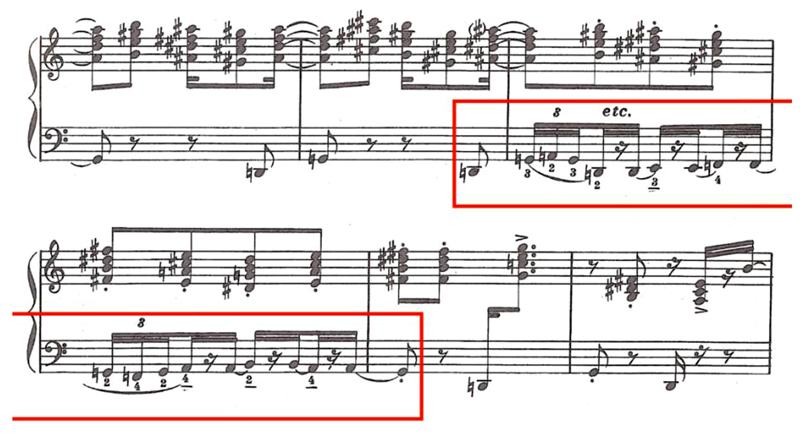
Example 5. Measures 41-46. Playful, flexible motif (in red rectangle) that occurs a few times in altered forms in the B section to lend some thematic stability to the chaos. |
Perhaps the most modern aspect of the B section is the lack of predictable phrases balancing each other, unlike those in the A section. In other words, the B section is generally "through composed" rather than parceled off into tidy, balanced phrases of equal length, as was the A section. Thus, cozy order gives way to excitable chaos midway in the composition.
Calm is restored to some degree with the return of the opening A section's tango, itself even more stabilizing than before by beginning in a comforting, reassuring E-major key rather than the initial minor one. This is not the calm after a storm, however, in that the composer has virtually rewritten the original A section to the extent that this is best labeled as "A1". Its original 22 measures have been expanded to an unsettling 34, and the originally easily singable, evenly phrased melody is less predictable and more changeable in melodic and rhythmic ways. This is evident immediately in its first twelve measures. See Example 6 and compare it to Example 2.
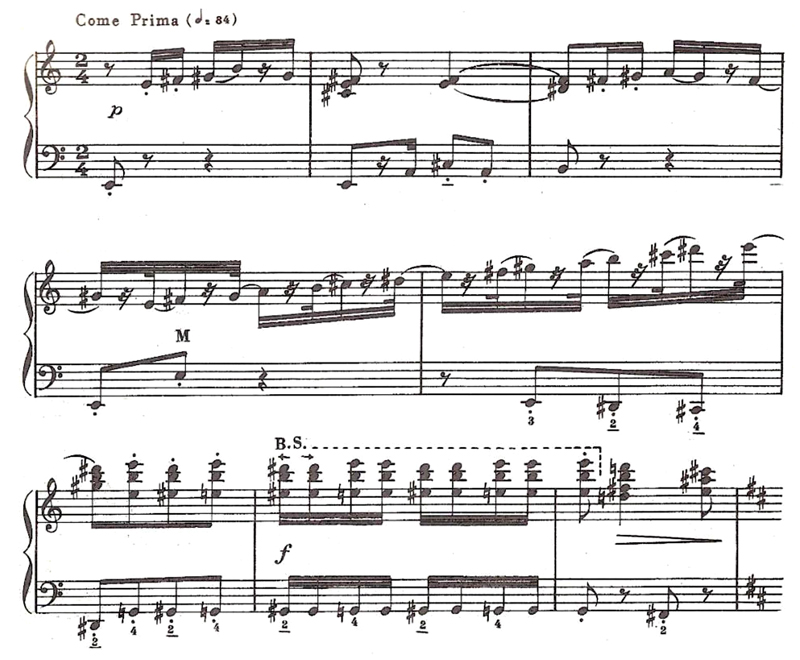
Example 6. Beginning of A1 section, and return of tango motive, now in E-major. Measures 84-91 |
The "coda" Riegger refers to in his brief description of Cooper Square is lengthy (36 measures) and developed enough to classify instead as a "terminal development" by customary analytical definition. Halfway through this lengthy ending is one final, strong statement in triple octaves of the main thematic motif, followed by a rapid E-major scale ascent to repeated strikes of the major tonic triad alternating briefly with its subdominant A-minor triad, as if to be a final plagal cadence, but, instead, continuing to be forcefully pushed yet further to the end by non-functional upper neighbor diminished triads.
All of this soon arrives at a melodramatic final and reassuring "tierce di Picardy" E-major tonic, dissonated, however, by the simultaneous interspersion of an A-minor subdominant triad in the bass grating against the tonic, thus creating a rueful and unexpected sort of "amen" plagal cadence at the last moment. See Example 7.

Example 7. Final 16 measures of the lengthy Coda |
Whether or not Riegger wrote a piece commemorating the Bowery's lively little restaurant visited regularly in the 1950s by both present and future jazz and contemporary music royalty (but likely not tango-playing Latin musicians customarily, if at all) is left to speculation since there is no known record in print or other sources of his ever mentioning it. This includes the correspondence between Riegger and Elsie Bennett that she so carefully preserved (often even down to summarizing visits and telephone calls with her target composers).
One commentator, Canadian accordionist Paul Shigrove, in his excellent performance of Cooper Square on YouTube (and posted on the AAA website's CCC works listing) simply describes the piece as a description of the busy hustle-bustle of the city: "With its abundance of erratic disjointed melodies & richly unpredictable rhythmic motifs, contrasting moods & wandering tonal center, [Cooper Square] is a wonderful expression of the storm & stress of city life." But why Cooper Square in particular, since the "storm and stress of city life" exists practically everywhere in Manhattan, and not more or less by any known count in this old, venerable city park area alone?
To conclude, one might validly complain that such a prominent American composer as Riegger, known mainly for his dodecaphonic works and inclusion by historians in the acclaimed circle of the highly eccentric, atonal-leaning "American Five," shortchanged the contemporary accordion world of the late 1950s with a basically tonal piece instead; and, worse yet, that it unfortunately served to possibly magnify the ethnic stereotype so many classical accordionists would rather not be re-emphasized among novice and often skeptical, easily dissuaded listeners to serious contemporary accordion repertoire. That said, Cooper Square is nevertheless a brilliant, well crafted, entertaining, and admittedly amusing concoction to which the composer clearly gave his best effort and well demonstrated his sincere interest in stressing the instrument's unique idiomatic properties. For these reasons it is a very worthwhile addition as a lighter selection to a contemporary classical accordion concert program.
Cooper Square was published by Pietro Deiro/Momac Music in 1958 and premiered, along with three later AAA commissions (Cowell's Iridescent Rondo, Robert Russell Bennett's Four Nocturnes, and Carlos Surinach's Pavane and Rondo), by Carmen Carrozza in the twenty-seventh season concert of the National Association for American Composers and Conductors, at Carnegie Hall, on November 21, 1959. New York Times critic John Briggs had brief, but very complimentary, things to say about each piece as well as both the instrument and performer. Regarding the Riegger selection he simply stated that it was a "showy display piece for accordion." It was commercially recorded in the 1980's by William Schimmel in his Finander/Atlantic LP Accordion Revisited.
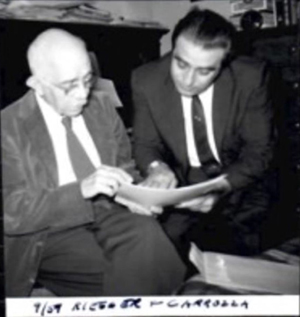
Wallingford Riegger with Carmen Carrozza, September 1959. Elsie Bennett photo album |
The AAA did not let its first commissionee, Paul Creston, rest for very long, for by 1958 he was once again brought into service by Elsie Bennett, this time to write a major composition for accordion and orchestra which would also be available in band transcription (though there is no known publication in the latter form to date, about which more below) and, as is customary with all concertos, with orchestral piano reduction for rehearsal or chamber performance purposes.
The Concerto is one of the most virtuosic works in the stradella accordion repertoire and consists of the traditional three movements, following the usual fast/slow/fast tempo scheme. Typical of all Creston's music, it is an attractive and highly accessible blend of jazzy syncopations, freely applied extended tertian chord structures, and modal scale sources (particularly the Lydian mode, which can be described to the layperson as a major scale with a chromatically raised fourth degree, e.g., F changed to F-sharp in the C major scale), with moments of translucent Debussyian "impressionism."
Both the publication (by Ricordi) for accordion and piano reduction of the orchestral part and premiere took place in 1960. Once again, Carmen Carrozza was to do the honors in introducing a new AAA commission to the world, this time with the Boston Pops Orchestra, under the direction of its famed and popular conductor, Arthur Fiedler. Present at the May 10 event at Boston's Symphony Hall was critic Harold Rogers, of the Christian Science Monitor, who gave as good a general description of the Concerto as any:
That [Creston] turned out an entertaining piece there is no doubt. Mr. Creston enjoys the use of syncopation; again and again he developed captivating rhythms for the orchestra while the solo instrument sang a haunting melody on its own. The opening Allegro maestoso alternated digital acrobatics with sustained, singing melodies. The Andante pastoral derived much of its harmonies and moods from the impressionists. There were the whole-tone progressions and certain progressions of the chords. The mood was bucolic-tranquil, contemplative, aspiring. The finale, Rondo presto, returned to a display of speed that kept Mr. Carrozza's right hand flying up and down the keyboard. |
A briefer and, all too common among critics when regarding the accordion, somewhat snarky, unsigned review appeared under the title of "Boston Proud of Symphony's Success in Japan Tour" in the June 1960 issue of the Musical Courier:
Another Pops guest was Carmen Carrozza, the concert accordionist, appearing in the premiere of Paul Creston’s Concerto for that much-courted and much-abused perpetrator of musical joys. The music disclosed lively rhythmic invention, which went far toward counteracting the harmonic categoricals of the bass push buttons. |
Creston was no stranger to new, under-represented instruments in contemporary concert music, for in the early 1940's he had produced a Concertino for marimba and orchestra and a saxophone concerto, both of which receive considerably frequent performances annually and, like the accordion concerto, remain important standard concert repertoire for those similarly latter day, "non-standard" instruments in Western classical music.
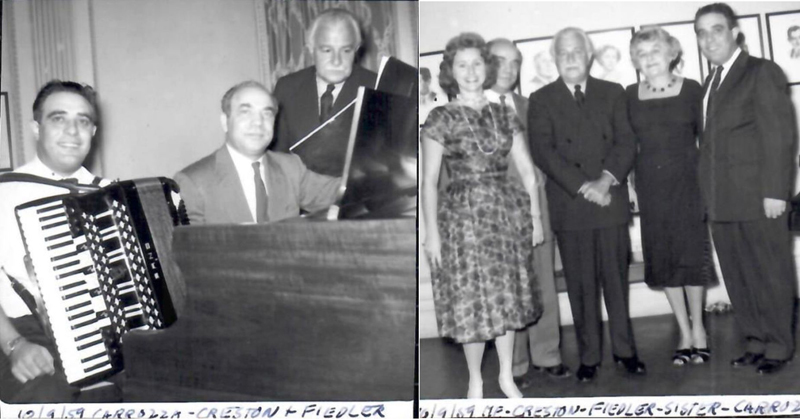
Carmen Carrozza, Paul Creston, Arthur Fiedler, Elsie Bennett, and Fiedler's sister Regina, October 9, 1959, presumably in Boston's Symphony Hall. Elsie Bennett photo album. |
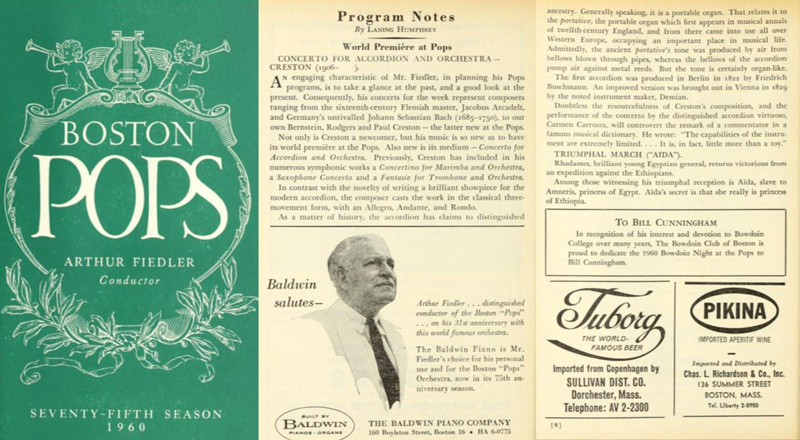
Cover of the 1960 Boston Pops program booklet for the 75th season, containing the program notes by Laning Humphrey of the Creston accordion concerto (pp. 5-6). A particularly important part of that text is in its final statement: "Doubtless the resourcefulness of Creston's composition and the performance of the concerto by the distinguished accordion virtuoso, Carmen Carrozza, will controvert the remark of a commentator in a famous musical dictionary. He wrote: ‘the capabilities of the instrument are extremely limited . . . It is, in fact, little more than a toy." The disdainful commentator was the highly regarded Victorian British composer and music theorist Ebenezer Prout (1835-1909), who at that time of his description of the accordion was Professor of Music at the University of Dublin. He wrote the article on the accordion in the 1904 edition of the prestigious Grove's Dictionary of Music and Musicians. It is very possible that Prout was basing his remarks on an outdated, more primitive form of the instrument at the time. It is certainly true that a 1960 concert level accordion was enormously superior and advanced in every way to any version of the instrument Prout was examining a half century earlier. |
The accordion concerto has enjoyed an impressive number of performances since its premiere. Firstly, Carrozza followed his debut with the BPO only a few weeks later on June 19, 1960, performing with the Bridgeport Civic Orchestra, Cesare Borgia, conductor, in that Connecticut city's Klein Memorial Auditorium; and, more prestigiously, fourteen years later on December 20, 1974, with the Cincinnati Symphony Orchestra, under the baton of its young, internationally celebrated American conductor Thomas Schippers.
In between this gap of major performances, there were quite a few by the huge number of rising "baby-boomer" generation accordionists born mostly between the mid 1940s and most of the 1950s. For example, I (born soon after D-day), have performed it twice with orchestra and twice with the Ricordi publication piano reduction accompaniment mentioned above. Many others, again including myself, have publicly played as an unaccompanied solo more times than we can count the flashy, fast-fingered last movement (a real "showstopper") which has only two very brief connective segments for orchestra alone that can very easily be played in transcription by the accordion. (In contrast, the first and second movements have too many extended tutti segments without the accordion to transcribe as effectively or fittingly to accordion solo throughout.)
More impressive, however, are two well-known and reported performances with noted symphony orchestras by Patricia Tregellas, with the Denver Symphony Orchestra, Saul Caston, conductor, November 21, 1961; and Diane Schmidt, with the Seattle Symphony Orchestra, Milton Katins, conductor, March 19, 1972. No doubt there are more such reports to be discovered internationally, especially by recent generations where the accordion draws a larger number of dedicated youth in the "classical" field than, sadly, the USA has in recent decades.

Carmen Carrozza taking a bow with Arthur Fiedler after performing the Creston concerto during one of its six evening concerts by the Boston Pops Orchestra, May 10-15, 1960, at Boston's Symphony Hall. Carrozza family collection. Following usual BPO protocol, the audience is seated at tables rather than theater seats (which are temporarily removed) in which meals are served dinner theatre style during the performances. Regular seating is always available, however, in other parts of the main floor and the two pairs of tiered balconies on both sides of the internationally acclaimed music hall. |

The programs in the above 1960 BPO season booklet for the first two (May 10, 11) of the six evenings in which Carmen Carrozza was the guest artist premiering the Creston concerto. Note that the rest of the program presents works entirely different from each other both evenings. This was generally true, with a few repetitions of some selections, for all six nights featuring Carrozza and the Creston concerto. All six programs may be viewed in their entirety online at https://archive.org/details/bostonpopsorches1960bost/page/n77/mode/2up |
A second regret is that, unlike Creston's marimba and saxophone concerti, the accordion concerto still awaits a commercial recording as of this writing (as is also true for Creston's other, later AAA commissioned work for accordion and orchestra, Fantasy, discussed in a later article in this series). However, perhaps the most important recorded performance in any form of the concerto will remain for posterity the premiere by Carmen Carrozza with Fiedler and the BPO during the week of May 8, 1960. The concert was repeated for six evenings in a row, beginning on Tuesday and ending on Sunday, May 15. Carrozza informed me that all evenings were recorded and that the best performance was saved for the BPO archive. Though not of top recording quality, the chosen performance is, as might be expected of one of the world's greatest, not to mention adventurous, accordionists and equally meticulous conductors of the time, excellent.
Carrozza was allowed a copy which the family has since put on YouTube for all to hear. Its link is also on the AAA website's AAA Music Commissions page. Still, it must be lamented that this great artist or at least any of his noted colleagues or any of their brilliant students never recorded the concerto on any of the numerous classical LP or CD labels available during the second half of the twentieth century.
A consolation to the above complaint, however, may be found via that great medium of the burgeoning twenty-first century, YouTube; for currently appearing therein in addition to the above mentioned Carrozza/Fiedler /Boston Pops Orchestra premier is a video recording of a live performance at the Auditorium Archivio di Statok in Bari, Italy, by accordionist Francesco Palazzo and the Orchestra della Città Metropolitana di Bari, Giovanni Rinaldi, conductor; and by Canadian accordionist Michael Bridge accompanied by pianist Cecilia Lee playing Creston's piano reduction of the orchestral score.* Though not produced in the ideal situation of a professional recording studio, all three renderings at least let the world know that such works exist for our instrument.
Like virtually all of Creston's vast output in practically every form for solo, chamber, orchestra, various instruments, voice, and chorus (he never produced an opera), his accordion concerto's second and third movements (though not his first, as will be described below) generally follow time-honored classical forms, being in this case those often found in the movements of the classical concerto, with clearly delineated and contrasting melodic themes.
What is different from other similarly "conservative" composers of the twentieth century, however, is Creston's melodic and harmonic language in general, which is a mixture of melodies often intermingling standard major and minor scale sources with modes (especially Dorian and Lydian), Debussyian whole-tone scales, and extended-third chords (7th chords of all types in all scale types, with added thirds beyond the 7th, forming 9th, 11th, and 13th chords), common also in much popular music and jazz. The resulting effect is a combination of dreamy impressionism with jazzy, blues-like moments. At other times, clear, unadorned traditional tonality holds forth for a few moments. Regarding rhythm, there are many instances of catchy, shifting rhythmic syncopation amidst otherwise straightforward traditional metrical motion. Despite such machinations, however, changes of meter during a movement or major section of a movement are rare in Creston's music.
The orchestration (full score and parts available only by rental, currently through Theodore Presser Music for the purpose of performance) is quite standard and economical, including no common supplementary or unusual instruments:
| 2 Flutes / 2 Oboes / 2 B-flat Clarinets / 2 Bassoons 4 F Horns / 2 B-flat Trumpets / 3 Trombones / Tuba / Timpani Strings (1st, 2nd violins, violas, cellos, string basses) |
In addition, there are few occurrences of non-accordion solo passages in the ensemble, the most noticeable exceptions being by the flutes and oboes in the slow middle movement; but there is much employment of the full brass section and timpani in the many highly dramatic moments in both outer movements.
There is apparently also at least one version arranged for accordion and band, though it is not known whether it is by the composer, since there is no known publication of such a score nor even an original manuscript in the Creston papers at UMKC or elsewhere. In fact, 1976 AAA National Competition winner and Creston authority Dr. Monica Slomski reported in her exhaustive doctoral dissertation on the composer's works at the University of Missouri Kansas City, and later published as Paul Creston: A Bio-Bibliography (Bloomsbury Academic, 1994) that at least two such performances by Carrozza took place within the decade of his BPO premiere: one with the United States Navy Band, Lt. Comm. Anthony A. Mitchell, conductor (though only the final movement was performed), at Carnegie Hall, February 20, 1966, a benefit concert for the AAA student scholarship fund according to an article in the New York Times the next day; and the other with the United States Military Academy Band, at West Point, New York, William H. Schempf, conductor, February 19, 1967.
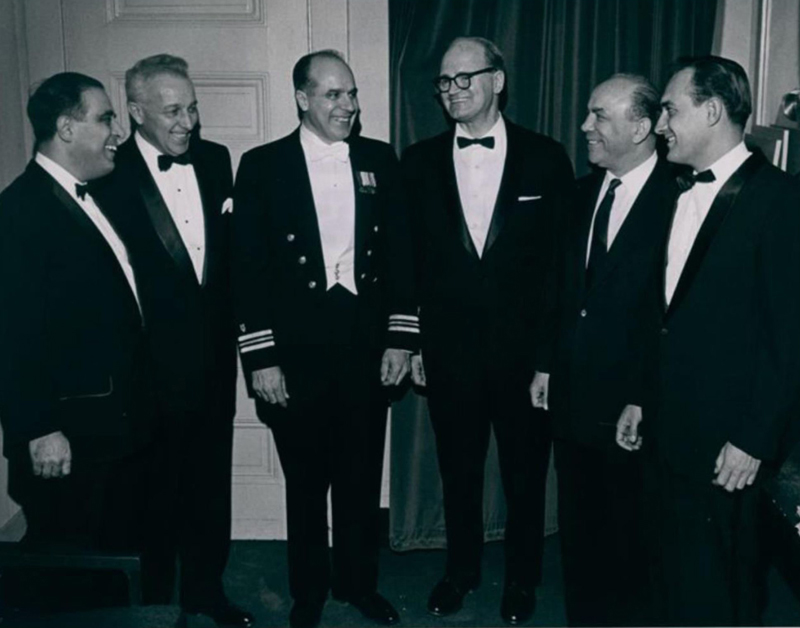
Carmen Carrozza, Pietro Deiro, Jr., conductor Lt. Comm. Anthony A. Mitchell, Charles Magnante, Paul Creston and Daniel Desiderio at Carnegie Hall following the US Navy Band performance by Carrozza and Mitchell of the third movement of the Creston accordion concerto, February 20, 1966. Paul Creston papers, University of Missouri Kansas City |
In addition to these events, a third was reported in the December 1965/January 1966 issue of Accordion and Guitar World that had occurred three months before the official premiere by the BPO. The occasion was the Midwest Band Masters Clinic, which took place at the Hotel Sherman in Chicago on December 16, 1960. Carrozza performed yet again only the flashy last movement with the band, led by guest conductor Arthur Fiedler.
From the above it is likely that only the final movement was performed with the West Point band, too. In my efforts to bring closure to this matter, I contacted these three organizations to see if they might possibly have locally created unpublished band arrangements of the concerto or at least its final movement preserved in their libraries. None did. Perhaps future research will yield different results, but for now the conclusion is that there is no published or extant unpublished arrangement of the concerto in either its entirety or just its third movement for accordion and wind ensemble.
One final item regarding instrumentation has not to do with that of the work itself but rather an unusual orchestral situation of the BPO for the concerto's premiere. It is a bit too amusing not to report here and falls under the category of "it's a small world":
Present in the audience at one of my own performances of the Creston Concerto, this in Fall 2006 with The College of New Jersey Symphony Orchestra, Philip Tate, conductor, on the TCNJ campus in Ewing, New Jersey, were Carmen Carrozza and an older, retired former colleague of mine on the music faculty (where I served as Professor of Music Theory and Composition from 1991 to 2020), flautist Dent Williamson (1931-2020). Immediately following the concert Williamson, a native New Englander and graduate of New England Conservatory, came up to me to report that he suddenly recalled during the program that he was in the woodwind section of the BPO at the time of Carrozza's premiere performances! That was a fun coincidence, of course, but he added, to my surprise, that the entire roster of the orchestra for that part of the concert season, himself included, did not consist of members of the BPO at all but rather were hired substitutes, thus rendering the ensemble a "pick-up" orchestra (populated, nevertheless, by excellent artists fully qualified for the job and under the always flawless direction of the BPO's omnipresent maestro, Fiedler).
Normally the BPO personnel were the same as those of the Boston Symphony Orchestra, though the sectional principals were not contractually obligated to participate in the BPO concerts. The reason for the switch during this period of the 1960 BPO concert season was that the Boston Symphony proper was abroad on a lengthy tour throughout Asia. This was overtly reported in print above the orchestra personnel list in the program booklet: "During the tour of the Far East by the Boston Symphony Orchestra, the Pop Concerts will be performed by the musicians here listed.”
The next time Dent saw me he kindly gifted me his saved copy of the program bearing his name in the orchestra roster. (See below.) In the photograph of the full orchestra above showing Carrozza standing to take a bow Dent is at the far left end of the woodwind section two rows directly behind the soloist (look for black hair and black rimmed glasses).
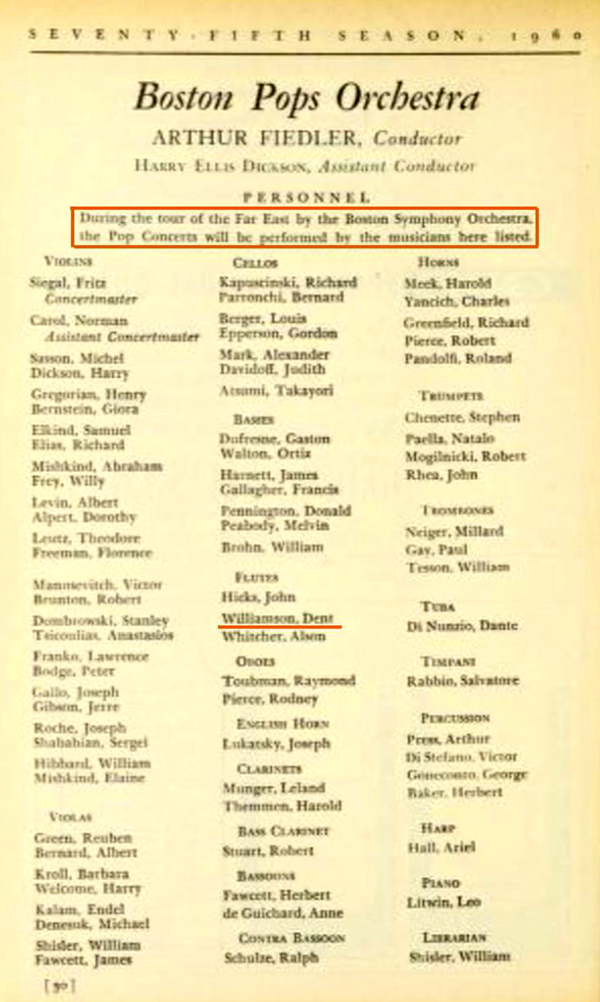
Boston Pops Orchestra temporary roster of musicians for part of the 1960 concert season, including flautist Dent Williamson, late colleague of the writer at The College of New Jersey. 1960/75th concert season BPO program booklet. An appreciation of Williamson and of his youthful association with the BPO may be read at https://artscomm.tcnj.edu/2020/01/24/tcnj-remembers-emeritus-faculty-dent-williamson/ |
Musical examination of the concerto now follows and will be introduced by the composer himself in an unpublished typescript preserved in the Paul Creston Papers at the University of Missouri Kansas City library. In it Creston precedes his brief description of the concerto with his recounting of his initial acquaintance with the accordion via Elsie Bennett's first of the four AAA commissions she offered him, the solo Prelude and Dance (described in the second article of this series that appeared in its original form in 1998). It is worth repeating here:
| Before accepting a commission for an accordion piece, I was accorded the opportunity of hearing the instrument in the hands of such artists as Charles Magnante and Carmen Carrozza, and loaned an accordion to learn to understand the technique of the instrument. In working with the accordion I was especially attracted to its primitive organ-like qualities and its great power of accentuation. (Although it is referred to as the "piano-accordion," my approach to the instrument is rather as a portable reed organ, which in reality it is.) I was also challenged by its limitation in chord-spacings, an element of harmony with which I have always been particularly concerned. By intensive experimentation, I succeeded in adhering to my philosophy of harmonic structure without any lowering of artistic standards. |
Then follows his general description of the Concerto:
| The concerto is in three movements: Allegro maestoso - Andante pastorale – Presto. The first movement is in modified sonata-allegro form with a rhapsodic, majestic "A" section and a lyric "B" section. The second movement is in three-part form and comprises a slow lyric section followed by a rather fast dance-like section in which the accordion plays arabesques against the orchestral counterrhythm and returns to an abbreviated version of the first section. In the final movement – in rondo form – the rhythmic element is predominant, the accordion's power of accentuation is exploited, and the soloist's virtuosity taxed considerably. |
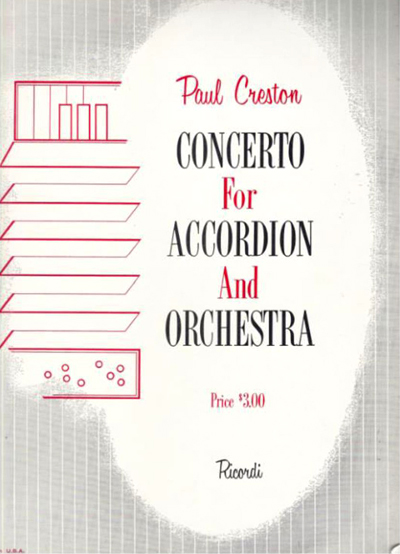
Cover of the original 1960 Ricordi publication of the score for accordion and the composer's piano reduction of the orchestra part, available for sale to the public, and from which all musical examples below are taken. |
First movement: Allegro maestoso (♩= 94-98, 4/4 meter)
The first movements of most traditional concerti of the past were in the sonata-allegro form Creston mentioned above, featuring a double exposition at the outset in which the orchestra alone performed the main themes in the tonic key of the first exposition after which the solo instrument entered along with the orchestra presenting a second exposition in which the second of the recurring themes was transposed to another key. A development section followed after which the recapitulation (a somewhat altered version of the exposition) was played by both soloist and orchestra entirely in the tonic key. A coda or more lengthy "terminal development" often occurred next which brought the movement to a dramatic close.
Despite his tendency to use such time-honored designs in his music, Creston chose instead to create a format quite different for the first movement of his accordion concerto (as alluded to in his description of the movement in the quotation above as being a "modified sonata-allegro" form). In so doing, he developed a rather short melodic idea ten times across the three A sections of a large A/B/A/B/A thematic plan (thus possibly suggesting that what Creston called an altered sonata allegro form could more properly be perceived as a "rondo" or at least the hybrid "sonata-rondo" format, often applied to final movements in the "Classical" and "Romantic" eras of past centuries), with differences of key and various other subtle changes at each item's occurrence.
Formal debates aside, appearances of each of the A phrase's permutations are played by the orchestra, the accordion, or both. See Example 8 for the first three of these phrases which constitute the beginning of the movement.

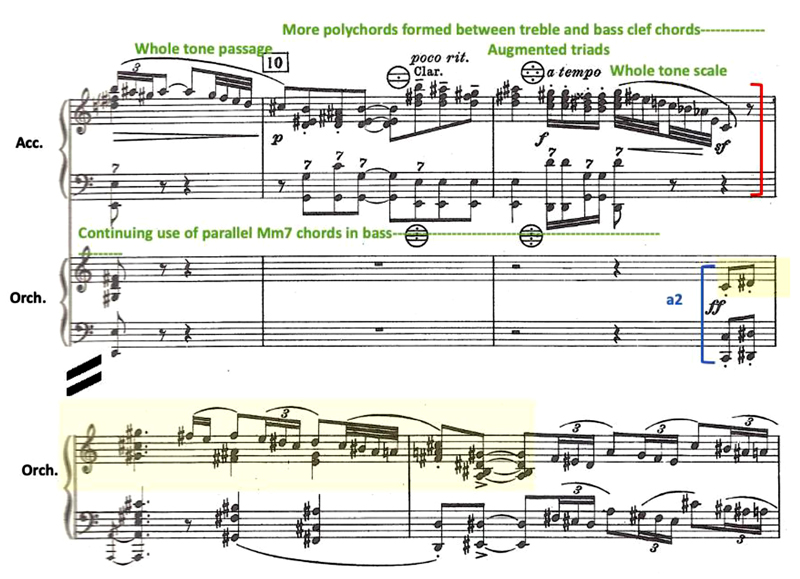
Example 8. The dramatic opening of the first movement of the concerto, section A (of A/B/A2 total movement format), measures 1-13 of 52. First three of the ten theme 1 beginning motive permutations highlighted in yellow, forming the beginnings of full phrases a, a1, and a2 of principal section I. Common "Crestonian" harmonic and melodic traits pointed out in green print include parallel planing of unstable harmonies such as augmented triads and major/minor 7th chords, melodic passages built on whole tone scales, tertian polychords often created by pairing two different major/minor seventh chords together, beginning of the A phrases in seeming keys that are immediately switched into uncertain tonal territory via free chromaticism. Many of these traits owe a debt to Debussy, particularly in Creston's use of unusual scales for melodic passages and parallel planing of traditional harmonic structures, breaking many rules of traditional tonality and blurring the lines between consonant and dissonant harmonies. |
The following chart offers an over-all view of the three A sections of the movement. The two interspersed "B" sections offer considerable contrast to those of the A sections and will be discussed and illustrated separately below.
Returning to the A section, the downbeat of most of its ten "a" segments therein are preceded by a rapid, dramatic upward- or downward-moving, multi-note anacrusis to the strongly accented principal harmony of each unit. However, these harmonies, while seeming to supply a sense of the tonic of a possible key, given their strong rhythmic position in their phrases, are often either extended-third or polychordal structures that are somewhat unsettled (though they may give the feeling of similar added-third tonics commonly heard in phrase endings in jazz).
Given that most of the harmony that follows in each such incident consists of either planing, non-functional major-minor seventh or extended third chords, augmented triads, or mixtures of both, they, plus freely applied chromatic pitches throughout any given phrase, virtually never settle into any definable tonic key despite their very periodic, mostly orthodox (though often syncopated) rhythm that leads the ear to many cadential resting points, whether or not they are traditional major or minor triads. Therefore, the chart will only define the quality of the initial downbeat chord with the understanding that it is almost always a "false lead" if perceived as a possible tonic function of the usually equally freely harmonized phrase and its ending chord to follow.


Turning now to the two intervening B sections, both feature a calmer, somewhat more tonally focused song-like theme, in relaxed contrast to the bombastic, churning melodic material of the surrounding A sections. The tonality is clearly in F-sharp Lydian mode initially, thus preserving a certain amount of impressionistic quality in the section.
A further somewhat hypnotic effect, though also a rather prominently jazzy, syncopated element, is achieved by a common Creston device in the form of two perpetually repeated ostinato accompanimental figures in the bass of the accordion and the lower instruments of the orchestra respectively. See Example 9 where their initial appearances are marked by a green and a red rectangle respectively. Also, the bass line in the orchestra constantly repeats the tonic pitch of the key in eighth notes, eventually descending stepwise to E, D, and C for similar periods of varying length in those modal keys (all in the Lydian mode).

Example 9. Beginning measures of the first of two B sections of the first movement displaying the first and beginning of the second melodic segments in F# and E Lydian mode respectively. Two more segments of varying lengths follow in D Lydian and C Lydian modes whose source scales are D E F# G# A B C# and C D E F# G A B respectively before the B section transitions to the A1 section described in the table above. |
The B1 section is very similar to B, complete with opening accordion left-hand and orchestral ostinati that soon became the persistent accompaniment to the B main theme, the latter once again being cast in mostly four-bar segments sounding initially a whole step lower each time using the Lydian mode. However, B1 turns out to be half the length of B, partly due to it having only three rather than four of the modal phrases this time. In addition, the accompanimental material and three melodic modal phrases they support are cast a whole step lower than the first three of the B phrase, starting this time with E, D, and C Lydian mode sources. Though shorter than B, B1 is perhaps a bit more dramatic, partly due to occasional full chord support of the melodic lines that were not present in B, and its arrival to a more intense final statement of A material leading to the climatic closing D-major rush to the cadence via tempi increases in the movement's concluding nine measures. |
Second movement: Andante pastorale (A & A1 sections: ♩ = 48; B section [poco più mosso]: ♩ = 60; 9/8 meter for entire movement)
As Harold Rogers so aptly described it above ("bucolic-tranquil"), and as its tempo marking, "Andante pastorale," makes clear, the second movement presents a calming midpoint between and escape from its two dynamic, driving outer counterparts. It also unabashedly and abundantly draws from the soft edged, dreamy moods and techniques of Debussy far more than its two neighbors and evokes a flowery aura not unlike that of early spring and new life. Its gracefulness is further enhanced by a flowing 9/8 meter.
The movement is dominated by three principle thematic elements whose main motives will be referred to here as:
| "A," plus a later sub-motive in its periodic phrasing structure that is prominent and frequent enough in my estimation to earn the label "A1", both of which are highly expressive and song-like. It is first introduced by the orchestra in C major at the beginning of the movement and then taken up by the accordion, with orchestral accompaniment, twelve measures later. The melody's bucolic quality, initially in C major and in perpetual and pleasant parallel harmonic thirds, is given a rustic effect by a accompanying persistent subdominant drone, F major, in the bass, a polytonal dissonance with which most motion picture audiences are familiar in countryfied film scenarios. The more flowing "A1" motive enters at measure 20, with normal harmonic accompaniment. Both A segments also feature moments of birdlike trilling, adding to this refreshing escape from the ponderous outer movements of the concerto. See Example 10. |
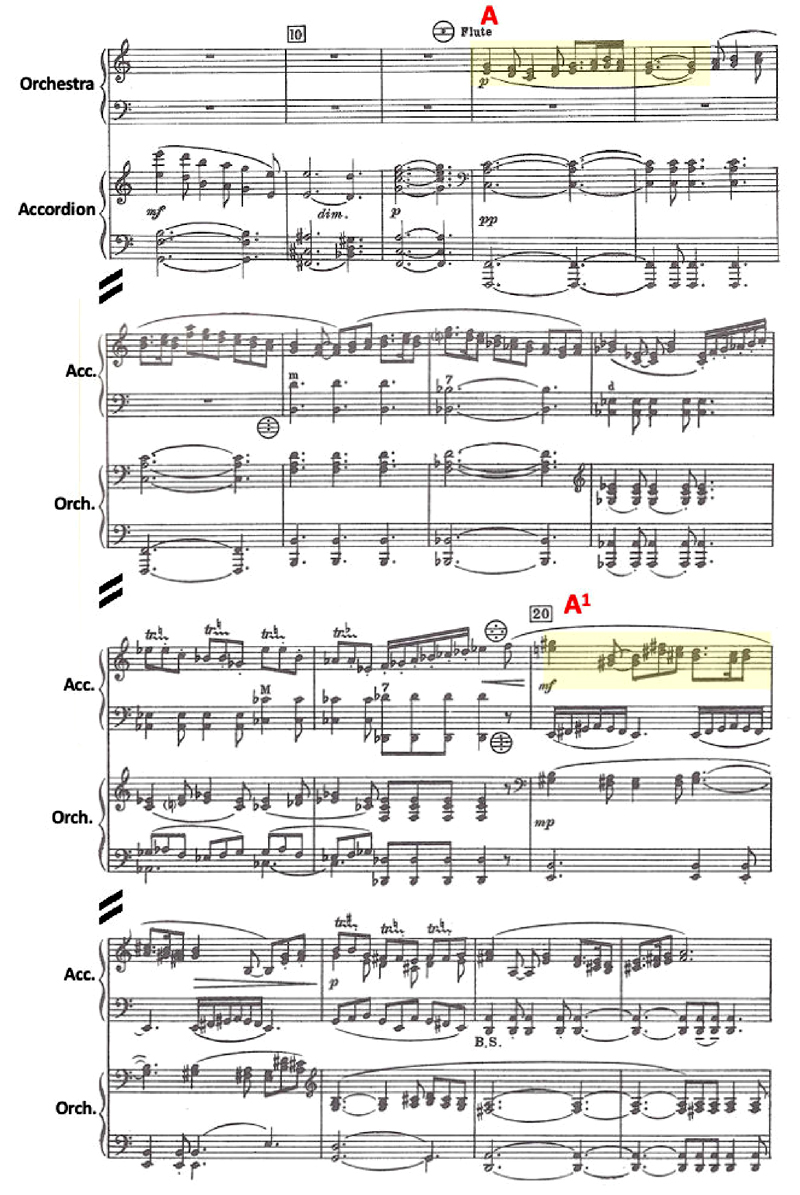
Example 10. Second movement, "Andante pastorale," measures 9-24. Initial entry of the accordion at measure 12 after the eleven-measure orchestral introduction bearing elements of the A motif of the A theme. Both of the two main motifs, A and A1, of the A theme's two contrasting segments are highlighted in yellow as they appear for the first time in the accordion part. |
| "B," a quietly fleeting theme whose main motive is pentatonic and dominated by gently rapid sixteenth-note nonets, initially introduced by the accordion in counterpoint with the recurring A theme in the orchestra at measure 52. Such double-themed counterpoint is a persistent feature of this initially homophonic movement. See Example 11. |
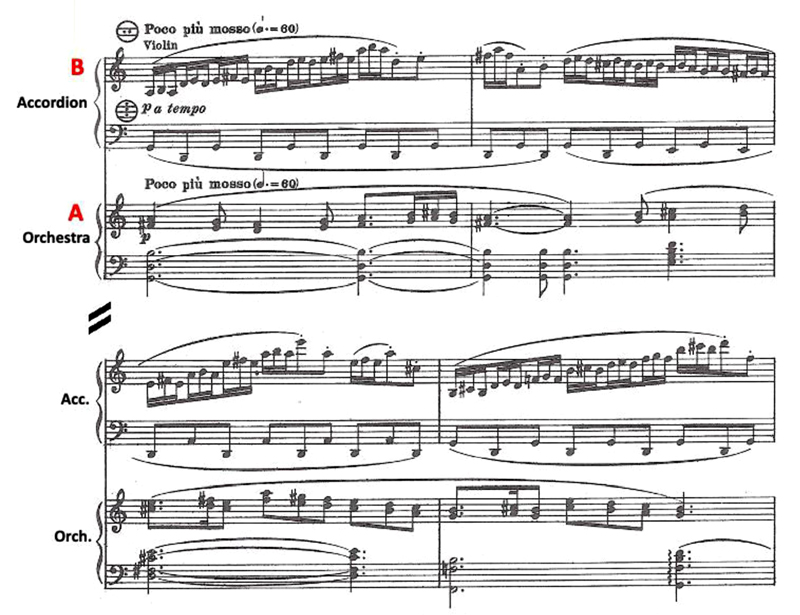
Example 11. Initial appearance in second movement of the capricious B theme by the accordion, in counterpoint with the A theme in the orchestra, measures 52-55. Hints of its arrival have preceded it by four measures in the accordion part via rising and falling sixteenth-note pentatonic nonets similar to the first ascending one in measure 52 of the B theme (A B D E F#). |
| "C," a similar theme to "B" (but lacking pentatonic phrases), introduced by the accordion in the treble manual at measure 75, undergirded by a bold, strongly accented, chordal accompanimental motif in the orchestra two measures earlier and joined by the bass manual of the accordion at its entry point. See Example 12. |
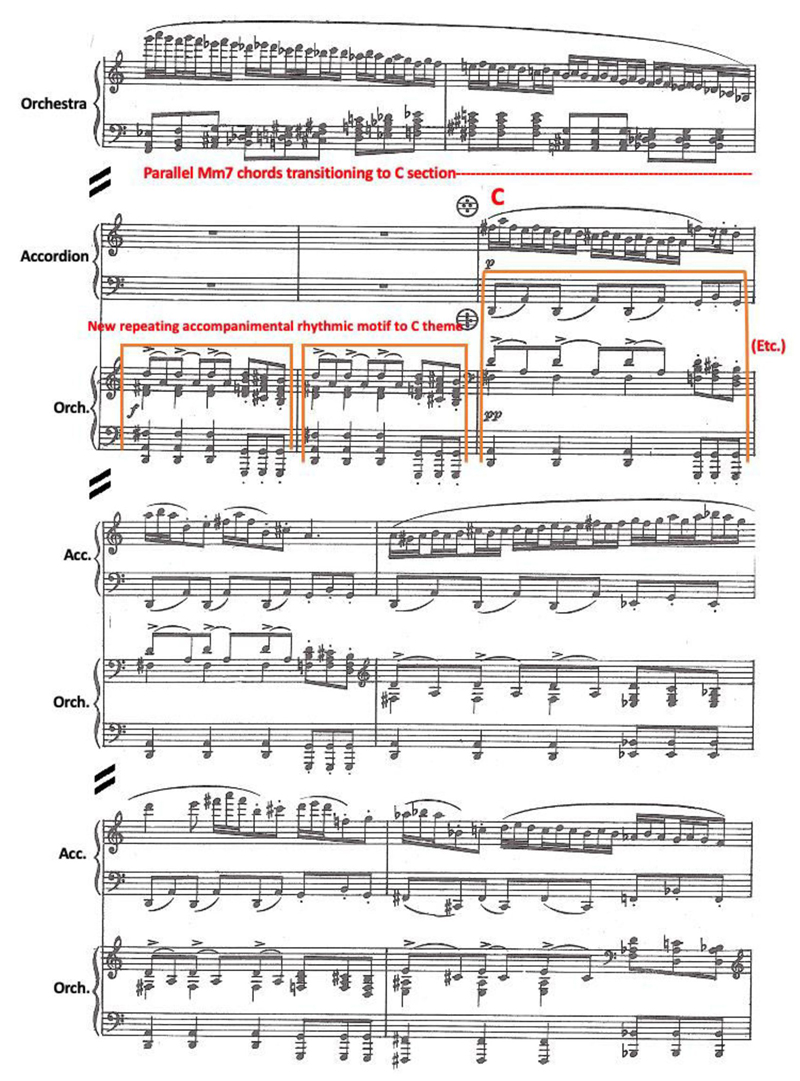
Example 12. Second movement, measures 71-79. Lively, flittering "C" theme (similar in some ways to the B theme), introduced in the right-hand manual by the accordion in measure 75 and accompanied by what will become a persistent repeating syncopated, stomping dance-like melodic motif in the orchestra and accordion's left-hand part beginning in measure 73. Both elements are introduced by a string of "impressionistic" parallel, non-functional major-minor 7th chords before coming into "focus" in D major at measure 73. |
The order of these elements and the roles of the accordion and the orchestra in this movement are displayed in the following diagram:
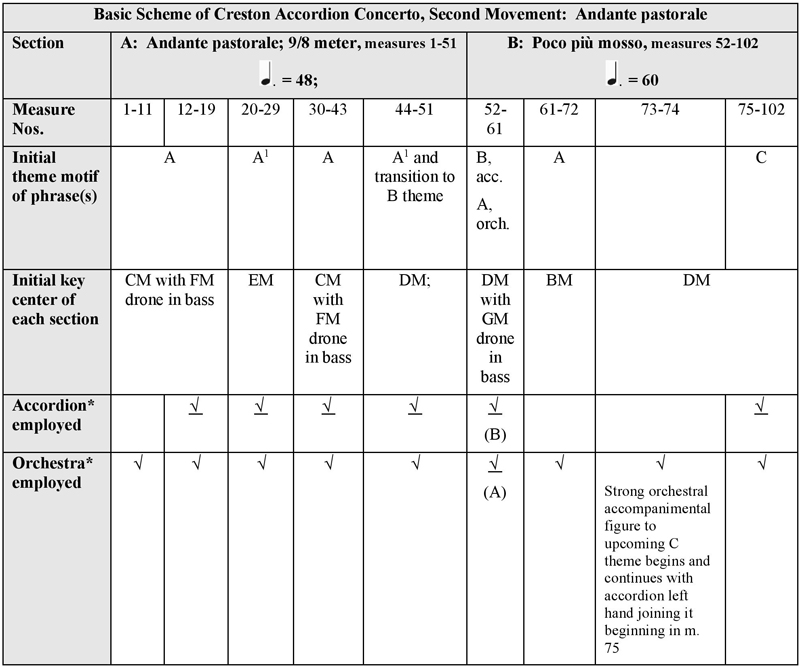
*When both accordion and orchestra are active at the same time, and one or the other is carrying the melodic theme, but not both, the check mark will be underlined as shown here with the carrier of the melody: Sometimes both accordion and orchestra carry two different themes in “double counterpoint” with each other, such as at mm. 52-61, and will both therefore have underlined checkmarks. |
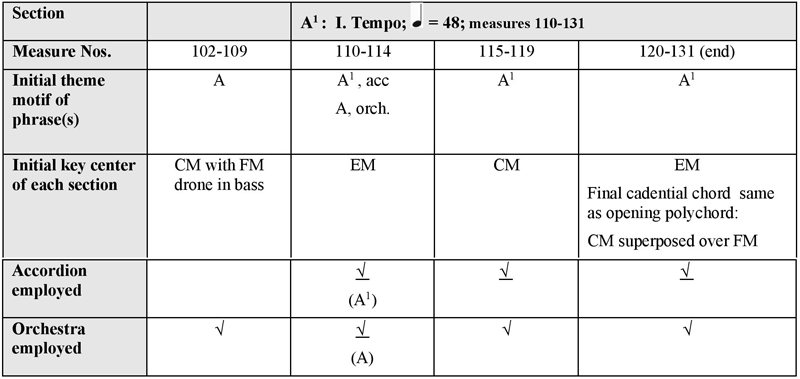
Third movement: Presto (♩ = 144-152, 2/4 meter)
The final movement is a highly virtuosic, wildly unleashed tour de force for the instrument. It is no less complicated to define harmonically and melodically than its two predecessors except in one way: It is more rooted to a tonic center which in this instance is A. Though there is no strict adherence to the diatonic harmonies of A major or minor (other than the tonic in the major key) and no sense of the all-important dominant and leading tone members of the key, E and G-sharp, there are strong points of rhythmic emphasis on the A major triad itself, the first being on the downbeat of measure 3 and the last its final cadential chord at the end 394 measures later.
In addition, and at least as important, there are three returns of the A section, typical in rondos, that all share the same principal opening motif in the same key, thus including the A-major harmony on their first strong downbeats as well. Furthermore, this strong motif occurs twice, at the beginning and approximately halfway through each return of the A section, thus bringing the total number of identical appearances of the motif and the emphasized A tonic to eight.
The fact that the scale of the key has a raised 4th degree (D# instead of D), rendering it A-Lydian, the first, third and fifth notes (A, C#, E), hence its tonic base, are unaffected and therefore remain an A-major triad.
Otherwise, most of the rondo's challenging runs and chords come and go through Creston's usual battery of ever-changing chromaticism, often creating multiple key center shifts in short order, jazzy added-third chords, and catchy syncopations, polychords, passages of non-functional, Debussyian parallel major-minor 7th chords or augmented triads, and melodies built more often than not on modes (especially Lydian).
Following a considerably classic rondo plan, the movement exhibits three distinct and easily recognized themes which will, in traditional analytical fashion be labeled here as "A", "B" and "C." Following is a brief overview of Creston's thematic layout for the movement:
A more detailed account now follows, after which three large and analyzed examples in score of the initial entrances of the movement's three principal themes (again, labeled as A, B, and C) will appear and be discussed.
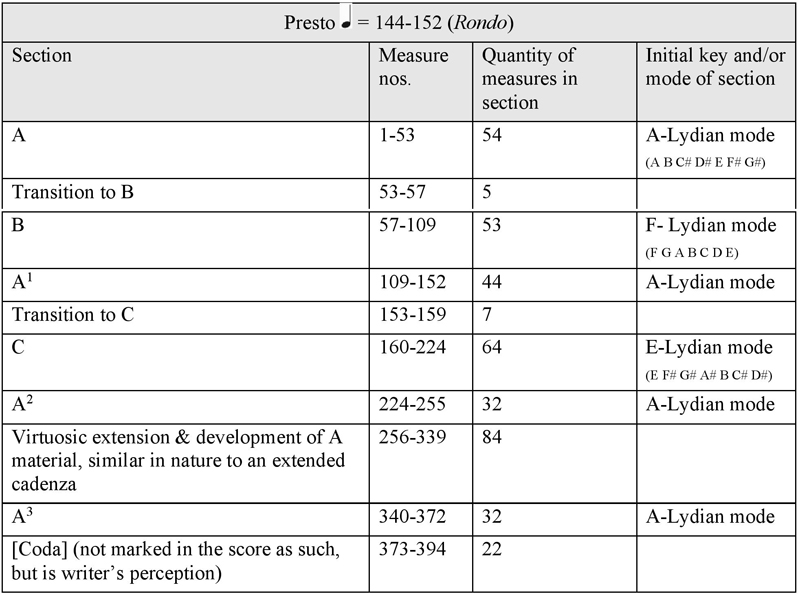
Following are three examples (Examples 13, 14, and 15) that display the initial entry of the A theme, which begins the rondo, and the B and C themes (respectively labeled as they are in the diagram above). The two returns of the A theme, not displayed here, undergo considerable variance in development and length. A particularly virtuosic section in the unbridled extension of A3, shown in Example 16, however, will display some of the imaginative and exciting development of that theme. The lengthy unfolding of the single occurrences of the B and C themes also develop into similarly extensive and imaginative tours de force beyond their beginning portions shown here.
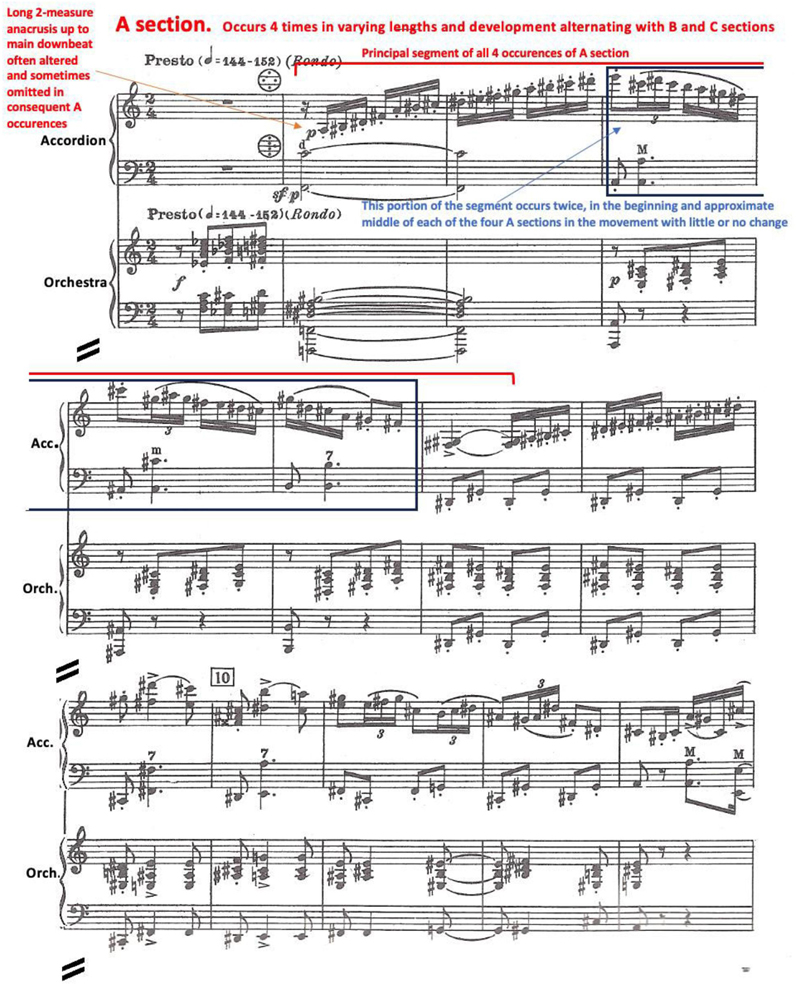

Example 13. Beginning of the third movement and A section, measures 1-21, including both occurrences of the principal "A" motif that will also occur twice in the later A1 and A2 returning sections of the rondo. |
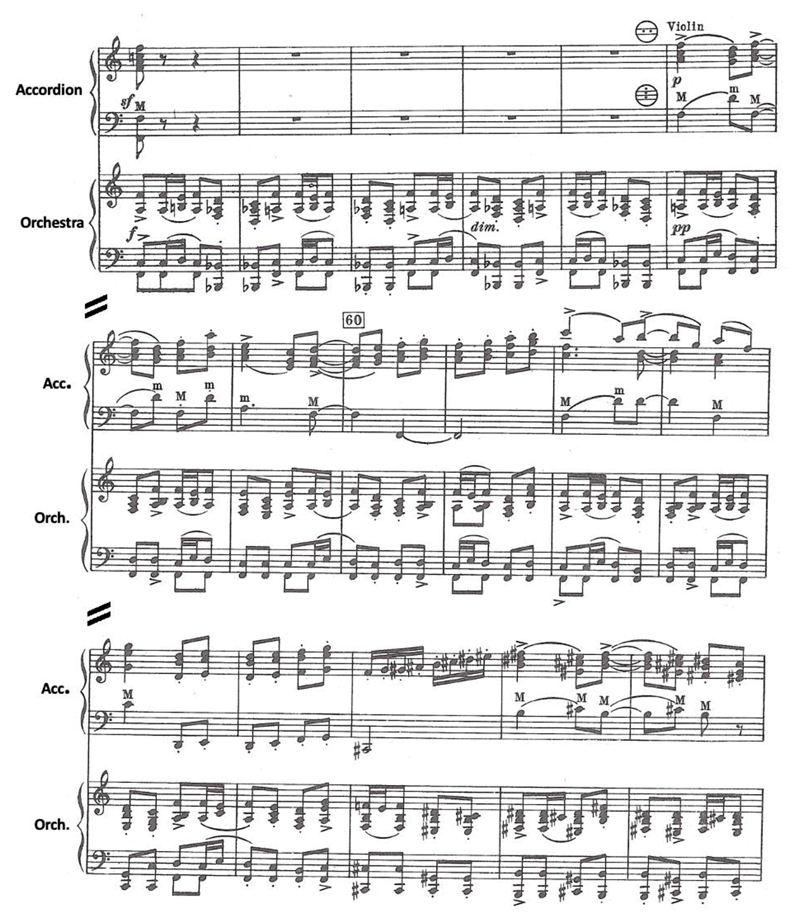
Example 14. Third movement, beginning of B theme, measures 52-68. Introduction of orchestral accompaniment, measures 52-56, employing perpetual two-and-a-half-beat, "hopping" rhythmic motif that becomes the syncopated and uninterrupted accompaniment to the accordion's similarly syncopated, playful theme "B," homophonically cast primarily in diatonic white-key triads, beginning at measure 57. |

Example 15. Third movement, beginning of C theme, measures 160-175. Song-like theme cast in soothing parallel harmonic 3rds in the accordion right-hand part with gently rocking slurred ostinato accompanimental figures, yet again in syncopated phrasing, in the left hand manual and orchestra. |

Example 16. Third movement, measures 307-330. Sampling of the degree of technical challenge in a long, cadenza-like developmental extension (though, unlike a typical cadenza, with perpetual orchestral accompaniment) of the second appearance of the A section (A2) of the rondo that begins at measure 256. |
There is no doubt that Paul Creston's accordion concerto was a major and triumphant, not to mention much needed, contribution to the accordion's contemporary classical repertoire during its mid-twentieth century ascendancy and that it has since enjoyed a considerable number of performances worldwide since the decade of its creation. Unfortunately, however, many of its performances have gone either under-reported or not reported at all, and if recorded, have not surfaced in social media or commercial recordings as of this writing sixty-three years after its world premiere in Boston.
Creston's more well-known and older concertos for two other "under-represented" instruments in classical music, the marimba (Concertina, for Marimba and Orchestra, 1939) and alto saxophone (1944; in addition to two chamber works, Sonata for Alto Saxophone and Piano, 1939, and Suite for Saxophone Quartet, 1979) have fared better in known performances and recordings (which can be instantly proven online by the multiplicity of You-tube recordings of both the saxophone and marimba concerti as well as the sonata as compared to a mere two presently for the accordion concerto, though there is a smattering of accordion concerti by other composers). This is no doubt due in large part to the realities that the saxophone and marimba are in greater demand in contemporary music, the marimba is one of many instruments a percussionist must be able to play to compete in the serious music field, and that there are far more "classical" saxophonists and percussionists than there are classical accordionists in the world to perform their major ensemble works.
A third major American composer discussed in this article and that Elsie Bennett successfully persuaded to contribute to the AAA's growing list of concert works, Virgil Thomson, had already had a long and eclectic list of major works behind him as well as a classic and invaluable early twentieth-century learning experience shared by many promising or already successful and famous composers of his time: compositional studies in Paris in the 1920s with the great Nadia Boulanger (following Thompson's service in World War I and graduation from Harvard University in 1922). While in Paris he also met and befriended the transplanted and enigmatic American poet and authoress Gertrude Stein, whom he convinced later in the early 1930s to supply a libretto for what is arguably his most famous work, a highly unusual opera, Four Saints in Three Acts.
Immediately noticeable to all listeners, but especially accordionists, is that from the very earliest bars of Four Saints the accordion is heard quite prominently in the score and continues to thread in and out of the orchestration throughout the greater part of the work. Such prominence and inclusion surpass by far other noted twentieth-century operas in which the accordion appears only briefly, and often only onstage for local color. Thomson treats it as an equal to the other instruments in the orchestration alone in Four Saints. In fact, he informed Bennett that he often incorporated it into quite a few of his other works, one of which, it can be argued, rivals Four Saints in notoriety, namely the seventh movement ("The Squeezebox") of his Acadian Songs and Dances for orchestra that served as part of the soundtrack of the initially controversial but ultimately very popular 1948 government film The Louisiana Story. **
Eight years before Bennett commissioned Thomson to write Lamentations (April 15, 1959, for $250, which at the present time of this revised article, 2024, would inflate to $2644) she met with him to discuss his views on the accordion and his use of it in past works.
The interview was reported and contained in an article by the Executive Vice president of Excelsior Accordions, Mario Pancotti, in the November 1959 issue of Accordion and Guitar World. In addition, Thomson's then recently completed AAA commissioned solo was announced and described by the composer. The interview and Thomson's comments on Lamentations were republished several months later by Bennett herself in the February 1960 issue of Music Journal, with a few corrections. Excerpts of the two slightly varying versions are combined here for best accuracy and are the exclusive words of Thomson, who first expresses his love for and the unique uses in his view of the accordion, and then his piece:
The accordion has huge accents, like trombones. It has volume; also soft sustained effect not unlike the harmonium, and it will mix easily with other instruments and can often be mistaken for strings. The accordion is closely related to and blends with the harmonium and strings, but it is not at all related to the brass and woodwinds. These can be played together, but as a contrast of sound. Because of its powerful accents, the accordion can be used in a manner similar to percussion, to hold a passage together rhythmically. I love the accordion. I've been writing for it for over 30 years. I like this instrument embodied within the orchestra. In fact, I like it better that way than sticking out against the orchestra. The accordion has terrific accents. I like the way it can snarl. I dislike any swishy kind of a sound. If amplification is used, it must be done with discretion, as it tends to make things "boom." In the hands of an artist, the accordion is a wonderful instrument. Lamentations might be said to be in three-part form, although it doesn't adhere strictly to form. Actually, there are a theme, three variations, and a re-statement of the first part. It could be called an accordion "etude," and has some very interesting and unusual effects. In one variation, there is a chord in the treble with three different and absolutely independent chords in the bass. It is a utilization of the structure of the accordion itself to produce a maximum dissonance content. Your left hand has only certain chords available but by contrasting the left and right hands, we have produced a harmonic richness. When writing double harmonies it's always better if each hand's harmonies are recognizable. You get a highly dissonant saturation. It's quite exciting, the fact that there is all of this dissonance going on but you can hear it as separate recognizable chords. |

Elsie Bennett, Carmen Carrozza, and Virgil Thomson at the composer's residence in New York's famous and somewhat notorious Chelsea Hotel, 1959. Elsie Bennett photo album. Carrozza once told the writer that Thomson often hosted lively parties there for his friends and associates and sometimes hired him to stroll and play popular tunes to enliven the occasion. However, at some point during the frivolity of the evening the composer would quiet the crowd and insist that Carrozza play Lamentations. Quite a contrast to a love song or a foxtrot! |
In strong contrast to the bright, major-key quality of Four Saints and Acadian Songs and Dances, Lamentations (subtitled "Etude for Accordion") does indeed make the accordion "snarl," especially in its identical opening and ending sections (referred to above as the "theme" by the composer), made up of violent, dissonant, clashing polychords, played fortissimo with the full master shifts of both right- and left-hand manuals wide open. The effect is rather terrifying in its steady stride of dissonant harmony, like an army of malevolent giants trampling all in their path. See Example 17 to view the first two and the beginning of the third of four distinct four-measure phrases (plus one more measure for the final cadence chord) of what is regarded as the "theme."

Example 17. Beginning of the powerful four-phrased, sixteen-bar dissonant polychordal theme (section A) of Lamentations. The tempo/expression marking over the first measure is the only such instruction for the entire composition. |
In-between, are four highly contrasting sections with very distinct motifs, thus suggesting a general thematic design for the entire composition of A/B/C/D/E/A. What is perplexing, however, is that Thomson described the work as having only three internal contrasting groups (thus resulting in an A/B/C/D/A general design instead) to which he also referred as "variations."
As best as I can tell from the composer's general remarks above which are inadequate to settle the question conclusively, he would most likely view my originally perceived A/B portions to be all A in two distinct sections (A/A1?), the first being sixteen bars of powerful, crashing exclusively homophonic polychords evenly divided into four phrases (thus a classic "double period" in theoretical language), and the next (A1), comprising seven more bars, and only approximately half the length of the first part of the section.
Perhaps this lack of symmetry is the best argument in favor of a two-subsection A section; but it must be observed that only the first sixteen of the thus assumed 23-bar A section returns at the end of the piece. (But Thomson does say above that the piece ends with a "restatement of the first part" [underlining mine], possibly meaning my designated A section without the ensuing A1 portion.) Both sections clearly cadence in the left-hand part on a C-minor triad, A's at measure 17 where it serves doubly as an elision with the initial harmonic support of A1.
In any event at this point, I shall leave this question of form up to the reader and any other examiner to draw their own conclusions, but will supply the following over-all diagram for the reader's reference as the various sections are sampled and described below:

The threatening, bombastic chords continue in the next segment of the A section (which I will now and hereafter refer to as A1 as I just designated above) in the bass for seven more measures while the treble counters it with a new motif, a hurricane of perpetual and devilishly difficult-to- perform sixteenth-note sextuplets made up of parallel harmonic major seconds in chromatic scale formations. (Cowell briefly commented to Bennett in their discussion that the sextuplets would render this passage "like the wind.") The left-hand part continues to feature sustained chords, similar in rhythm to the opening sixteen bars, but in various 7th chord constructions instead of the opening plain major and minor chord mixtures displayed in Example 17. See Example 18 to examine the beginning two bars of this section (A1).

Example 18. Beginning of second part (A1) of opening theme of Lamentations, measures 17-23, with continuing thematic chords in the bass accompanied by rapid chromatic runs in dissonant harmonic major 2nds in the right hand, the latter described by Thomson as being "like the wind." |
This tension is hardly relieved by the three sections that follow, deemed variations in the composer's words above (but not, interestingly, in print in the score itself) and which I will now formally label B, C, and D in my outlining of the work as a whole.
Lamentations treats the notion of theme and variations differently in some ways from past masters in Western music. Normally, most works of this genre follow the opening, unadorned theme with variations of approximately the same length in measures despite expected changes in mood, tempo, and, often, meter and key or at least mode (e.g., switching from major to parallel minor, or vice versa). It is also more common than not to entitle or at least subtitle such works as "Theme and Variations," and to label the theme and oftentimes the number of each variation in the score, separating all these sections from each other more often than not with double barlines (serving as an aid to the performer). Thomson follows none of these manuscript traditions in his score. The return of the unaltered theme (A sans A1) at the end of the set of variations in Lamentations is also uncommon in theme and variation form. (A common exception, though, is in jazz where it is the tradition to begin with a considerably straight-forward, recognizable rendition of a popular song before taking "riffs," which are essentially improvised variations, on it, after which a straight version of the song returns as a kind of coda.
Another way one might view Thomson's ending his piece with the unaltered opening A theme, however, is that it follows a common procedure in the often-applied form of minuet or scherzo and "trio" movements of instrumental music in the eighteenth and nineteenth centuries. They were large ABA sections subdividable into simple or rounded binary forms that commonly constituted the third of a four-movement work, and that returned da capo to their unaltered A segment to bring the movement to a close.
These clever formal irregularities in Lamentations aside, the three variations (again, sections B, C, and D) are nonetheless in keeping with certain traditional theme and variation procedures in that they are strikingly different from one another in all respects (melodically, rhythmically, and expressively) even to the point of register changes, particularly noticeable in the right-hand choices ("bassoon," "violin," and "oboe" stops respectively); but despite the obvious differences in meter among the three (12/8, cut time, and 3/4 respectively, though only the last is marked in the score, the other two being aptly notated to stay within prevailing common meter format), there is, as observed above for the entire work, no double bar between each variation in the score to reinforce visual confirmation of change of section to the performer that such is the case.
Furthermore, the lengths of the three thematic sections are remarkably different from each other and the opening theme (A section, 17 measures in length) itself: section B (measures 24-31) is eight measures long; C (measures 32-37) lasts for six measures; and section D (measures 38-56) for nineteen, five measures greater than sections B and C combined. However, the former two, though melodically quite different from each other and any other sections of the entire composition are accompanied in their non-melodic-bearing manuals (right-hand for variation B and left-hand for C) with nearly exact recurrences of the crashing chords of the theme-setting A section: the right-hand chords of measures 9 through 16 of A accompany the left-hand melody of B; and the left-hand chords of A's measures 1-8 accompany the right-hand melody of C.
Therefore, Variations B and C, though melodically very different from each other, are simultaneously only one unit in effect due to all the accompanying chords from the beginning half of the Theme (A) that recur against them, only in reverse order. See Examples 19 and 20. (Could this mean, then, that these two units, presently labeled as B and C, now be actually viewed together as a single variation, hence section C alone, and that the now so-called A1 section actually be the B section and hence the first variation after all? Again, I will leave this to the reader to re-examine, if so desired, but will stay with the plan to which I have already conceded for the rest of the article.)
Right-hand triads are the same as those in right hand of measures 9-14 of A section except for those in parantheses.
Example 19. Measures 24-29, beginning of B section, the first of three variations as described by the composer. A lilting melodic line played exclusively on diminished chord buttons in the left-hand manual accompanied in the right-hand manual (sounding an octave lower than written due to the employment of the dark, rich sounding "bassoon" register), by a reiteration of the second half of the right-hand part of the A theme's harmonic progression (see last two measures of Example 17 for beginning of the phrase). |

Example 20. Measures 32-35, beginning of C section, the second of the three variations, abruptly following the B section. Strongly contrasted right-hand melody to that of section B's left-hand chordal theme in that the former is in parallel major 3rds based largely on the whole-tone scale. However, the two sections are bound together via accompanimental block chord progressions taken from section A, in this instance from A's opening left-hand harmonies (see Example 17, left-hand part, phrases 1 and 2). |
Before discussing variation D, another difficult virtuosic challenge in Lamentations besides the rapid right-hand harmonic major 2nd runs described above in the second large segment (A1, measures 17-23) of the Theme is the melodic theme to be played exclusively on the diminished chord row of the left-hand manual in variation B (again, measures 24-31). To explain to non-accordionist readers, the accordionist cannot see the left-hand manual and therefore relies heavily on certain indented buttons in the "fundamentals" row (of which there are four, A-flat, C, E, and C-sharp, each pair separated by three non-indented buttons) for orientation to the complete button layout.
This makes playing as if by braille very workable when the usual mixtures of dented and undented buttons are frequent in virtually any bass passage (which is practically 100 percent of the time). The diminished chord row, as well as the other five remaining button rows (major, minor, major-minor 7th chord rows and "counterbass" row of single pitch notes), however, has no such dented marker buttons, making the task considerably risky when compelled to use only that row for an entire passage, especially with so many wide skips required at the rather brisk pace this eighth-note triplet-dominated segment demands of the player.
That said, the "meshy" effect of a melody consisting of rapid diminished chords alone constitutes an interesting, rather ghostly melodic/harmonic effect, especially since in all music there are only three sounding diminished 7th chords each of which has entirely different pitches from each other in the tempered chromatic scale, the latter being the twelve pitches upon which virtually all Western music is constructed. This technical fete at a pushing tempo can only be achieved on the stradella, or so-called "120-bass" left hand system with any degree of fluency, especially when legato phrasing is required as it is in in these passages. **
Before continuing with this analysis, this may be a good point at which to discuss the subtitle of Lamentations and some other general aspects of the piece:
Idiomatically conceived, fast-moving, short single-movement works such as this that are devised to technically challenge the technique and musicality of a performer's command of a specific instrument are often generically titled "etudes," literally meaning "studies." Chopin's highly virtuosic 27 Ètudes in three sets idiomatically conceived for the concert pianist are famous examples, so it is clear why Thomson added that subtitle to his Lamentations.
Secondly, beyond being just a short virtuosic work, and thus understandably deemed an etude on that basis alone, it is also possibly conceivable that Thomson's accordion offering is a hybrid of not only theme and variations (as pointed out above despite some liberties taken) but, given parts of the somber chordal opening theme recurring in part simultaneously with their variations in consequent sections (B and C sections, as just discussed), a "ground bass" concoction, at least at times, as well.
Works bearing the last description harken back to the Baroque era and were normally labeled and often entitled "passacaglia" or "chaconne," both originally popular dance forms that normally presented a brief repeating melodic line, usually in the bass, or a repeating chordal progression, that, in the purest of instances, continued to be repeated unaltered any number of times against its own variations in counterpoint in the other parts. Possibly the most famous of all examples of this often-applied genre of that era is Johann Sebastien Bach's spectacular Passacaglia in C-minor, for organ.
Turning now to the D section, the third and final variation of the opening A theme according to the composer, we encounter the only section in which Thomson briefly diverted from common to triple meter.
This section also carries less obvious harmonic and melodic traits of the A theme than did the previous two variations. Its only clear relationship to the theme is its exclusively homophonic, plodding, though now quieter, character. Its triple meter signature, slow, somber, halting-step mood (stiffened even more by the instruction in the score to play from one chord to the next "non-legato") and the occasional shifting of the natural pulse from the first beat to that of the second (via quarter note to half note successions) result in what could be described as a stately and almost ceremonial saraband, one of the traditional dance forms used so often in Baroque era harpsichord suites and other instrumentations.
Both manuals' parts are purely harmonic, thus in strict chorale style (again, common with sarabands), and utilize only major-minor 7th and fully diminished 7th chords (or their enharmonic spellings) in both the right- and left-hand parts, with only a few exceptions.
Furthermore, the entire segment is a strict rhythmic canon, initiated in the left hand and imitated in the right in the next measure. Likewise, the right hand imitates all the harmonies of the left hand equally strictly with very few exceptions. See Example 21 for the beginning of this 19-measure section.

Example 21. Measures 38-44, beginning of canonic D section and Thomson's designated third variation of A section materials. Somber, saraband-like style and only section of Lamentations that departs from common meter (though continuing at the same quarter-note-per-beat tempo). The inserted blue lines highlight the treble staff's exact rhythmic and near exact chordal imitation of the bass part during this segment. Note: some diminished harmonies are enharmonically respelled (or "misspelled") for easier reading in performance. |
Having examined its unusual structure and form, one might be equally puzzled by the title of this curious piece: "lamentations" for whom or what? No explanation in print or live conversation is known to have been offered by the composer, but its imposing, powerful, and certainly sublime main theme and enigmatic variations seem enough, alone, to merit its somber title. One might wonder if it was influenced at least in its opening section by a similar but much lengthier and even more sublime and imposing single-movement offering, Sun-treader (1931). This orchestral masterpiece was composed three decades earlier than Lamentations by another great American composer and contemporary of Thomson, the eccentric and crusty New Englander and member of the notoriously adventuresome "American Five," Carl Ruggles (1876-1972), mentioned above in association with Wallingford Riegger. Unlike Thomson, however, Ruggles did explain his similarly cryptic title, which was taken from Robert Browning's epithet for Percy Bysshe Shelley. Both are truly gripping and wonderfully powerful works despite their differences in length, complexity, and instrumentation. ****
Lamentations was published by Santee Music Press in 1960 and premiered by Carmen Carrozza in a recital of commissioned works by both the AAA and the ATG he gave for the prestigious Chicago Arts Club on February 11, 1961. Unfortunately and unforgivably, the program received no reviews from that city's press. However, Carrozza played it on two later occasions in the year, in New York, in the same NAACC concert he premiered Riegger's piece at Carnegie Hall on April 17, and the composer's sixty-fifth birthday concert at Town Hall, on December 18. Brief mention was made of the piece by Paul Lang in the New York Herald Tribune ("Lamentations sounded like ersatz organ music, but Carmen Carrozza is a real virtuoso on the belly organ") and Harold Schoenberg in the New York Times ("... Carmen Carrozza produced piercing harmonies").
1959 was a very busy and fruitful year for the AAA Composers' Commissioning Committee in that not only Virgil Thomson accepted the AAA's invitation to add to the accordion's serious repertoire at that time, but so did three other equally luminous figures: Robert Russell Bennett, Carlos Surinach, and Henry Cowell. Their contributions will be discussed in the next article of this series.
*All three of these performances of the Creston accordion concerto are easily located online by simply typing "creston accordion" in the subject line.
**The entire work may be heard on YouTube at
https://www.youtube.com/watch?v=THDLkcm54F4 The "Squeezebox" movement begins at marker 11:39.
*** For non-accordionist readers who are curious to know more about the accordion’s left-hand stradella (also called “120-bass”) system, see my manual Composer’s Guide to the Piano Accordion, pp. 2-3, on the AAA website at https://www.ameraccord.com/commissions/ComposersGuide.pdf; and
“Registers of the Standard Stradella Keyboard,” by Donald Balestrieri, at https://www.accordions.com/articles/stradella.aspx
****Recordings of Sun-treader are easily found on YouTube.
The AAA Composers' Commissioning Committee welcomes donations from all those who love the classical accordion and wish to see its modern original concert repertoire continue to grow. The American Accordionists' Association is a 501(c)(3) corporation. All contributions are tax deductible to the extent of the law. They can easily be made by visiting the AAA Store at https://www.ameraccord.com/cart.aspx which allows you to both make your donation and receive your tax deductible receipt on the spot.
For additional information, please contact Dr. McMahan at grillmyr@gmail.com
Latest NewsElections for 2025-2027 AAA Executive Board were held November 12, 2024 2024 AAA 86th Anniversary Festival Daily ReportsJuly 12-14, 2024
2024 AAA Color Journal (36 pages) 2023 AAA 85th Anniversary Festival Daily ReportsJuly 12-16, 2023
2023 AAA Color Journal (47 pages) AAA History ArticlesHistorical Articles about the AAA by AAA Historian Joan Grauman Morse Music CommissionsOriginal works commissioned by the AAA since 1957
Recent articles: Download Composer's Guide to the Piano Accordion
AAA NewslettersLatest newsletters are now online. |